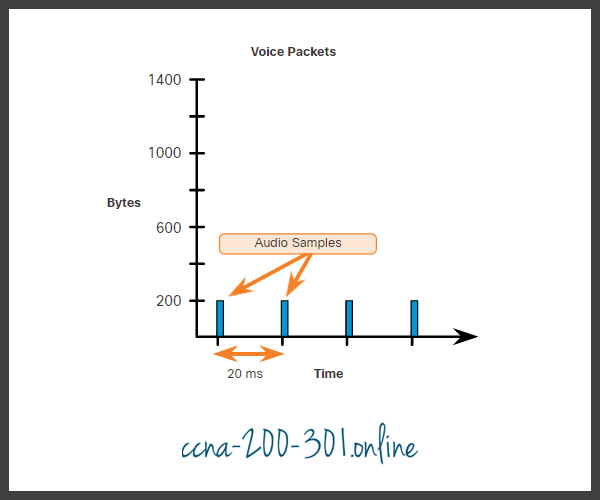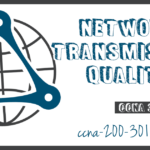Traffic Characteristics
Summary
This topic describe minimum network requirements for voice, video, and data traffic. Start learning CCNA 200-301 for free right now!!
Table of Contents
Video Tutorial – Traffic Characteristics
Click Play for an overview of how QoS can be used to treat packets differently based on the characteristics of the traffic.
Network Traffic Trends
In a previous topic, you learned about network transmission quality. In this topic you will learn about traffic characteristics (voice, video, and data). In the early 2000s, the predominant types of IP traffic were voice and data. Voice traffic has a predictable bandwidth need and known packet arrival times. Data traffic is not real-time and has unpredictable bandwidth need. Data traffic can temporarily burst, as when a large file is being downloaded. This bursting can consume the entire bandwidth of a link.
More recently, video traffic has become the increasingly important to business communications and operations. Consider that organizations now commonly use video conferencing to meet with users and clients, high definition video surveillance to remotely monitor facilities and equipment, and video streaming for a variety of purposes including training. According to the Cisco Visual Networking Index (VNI), by 2022 video will represent 82% of all internet traffic. In addition, mobile video traffic will reach 60.9 exabytes per month by 2022.”
Voice
Voice traffic is predictable and smooth, as shown in the figure. However, voice is very sensitive to delays and dropped packets. It makes no sense to re-transmit voice if packets are lost; therefore, voice packets must receive a higher priority than other types of traffic. For example, Cisco products use the RTP port range 16384 to 32767 to prioritize voice traffic. Voice can tolerate a certain amount of latency, jitter, and loss without any noticeable effects. Latency should be no more than 150 milliseconds (ms). Jitter should be no more than 30 ms, and voice packet loss should be no more than 1%. Voice traffic requires at least 30 Kbps of bandwidth. The table gives a summary of voice traffic characteristics and requirements.
| Voice Traffic Characteristics | One-Way Requirements | |
|---|---|---|
|
|
|
Video
Without QoS and a significant amount of extra bandwidth capacity, video quality typically degrades. The picture appears blurry, jagged, or in slow motion. The audio portion of the feed may become unsynchronized with the video.
Video traffic tends to be unpredictable, inconsistent, and bursty compared to voice traffic. Compared to voice, video is less resilient to loss and has a higher volume of data per packet. Notice in the figure how voice packets arrive every 20 ms and are a predictable 200 bytes each.

In contrast, the number and size of video packets varies every 33 ms based on the content of the video, as shown in the figure. For example, if the video stream consists of content that is not changing much from frame to frame, then the video packets will be small, and fewer are required to maintain acceptable user experience. However, if the video steam consists of content that is rapidly changing, such as an action sequence in a movie, then the video packets will be larger. More are required per the 33 ms time slot to maintain an acceptable user experience.

UDP ports such as 554, are used for the Real-Time Streaming Protocol (RSTP) and should be given priority over other, less delay-sensitive, network traffic. Similar to voice, video can tolerate a certain amount of latency, jitter, and loss without any noticeable effects. Latency should be no more than 400 milliseconds (ms). Jitter should be no more than 50 ms, and video packet loss should be no more than 1%. Video traffic requires at least 384 Kbps of bandwidth. The table gives a summary of video traffic characteristics and requirements.
| Video Traffic Characteristics | One-Way Requirements | |
|---|---|---|
|
|
|
Data
Most applications use either TCP or UDP. Unlike UDP, TCP performs error recovery. Data applications that have no tolerance for data loss, such as email and web pages, use TCP to ensure that, if packets are lost in transit, they will be resent. Data traffic can be smooth or bursty. Network control traffic is usually smooth and predictable. When there is a topology change, the network control traffic may burst for a few seconds. But the capacity of today’s networks can easily handle the increase in network control traffic as the network converges.
However, some TCP applications can consume a large portion of network capacity. FTP will consume as much bandwidth as it can get when you download a large file, such as a movie or game. The table summarizes data traffic characteristics.
| Data Traffic Characteristics |
|---|
|
Although data traffic is relatively insensitive to drops and delays compared to voice and video, a network administrator still needs to consider the quality of the user experience, sometimes referred to as Quality of Experience or QoE. There are two main factors that a network administrator needs to ask about the flow of data traffic:
- Does the data come from an interactive application?
- Is the data mission critical?
The table compares these two factors.
Factors to Consider for Data Delay
| Factor | Mission Critical | Not Mission Critical |
|---|---|---|
| Interactive | Prioritize for the lowest delay of all data traffic and strive for a 1 to 2 second response time. | Applications could benefit from lower delay. |
| Not interactive | Delay can vary greatly as long as the necessary minimum bandwidth is supplied. | Gets any leftover bandwidth after all voice, video, and other data application needs are met. |
Ready to go! Keep visiting our networking course blog, give Like to our fanpage; and you will find more tools and concepts that will make you a networking professional.





